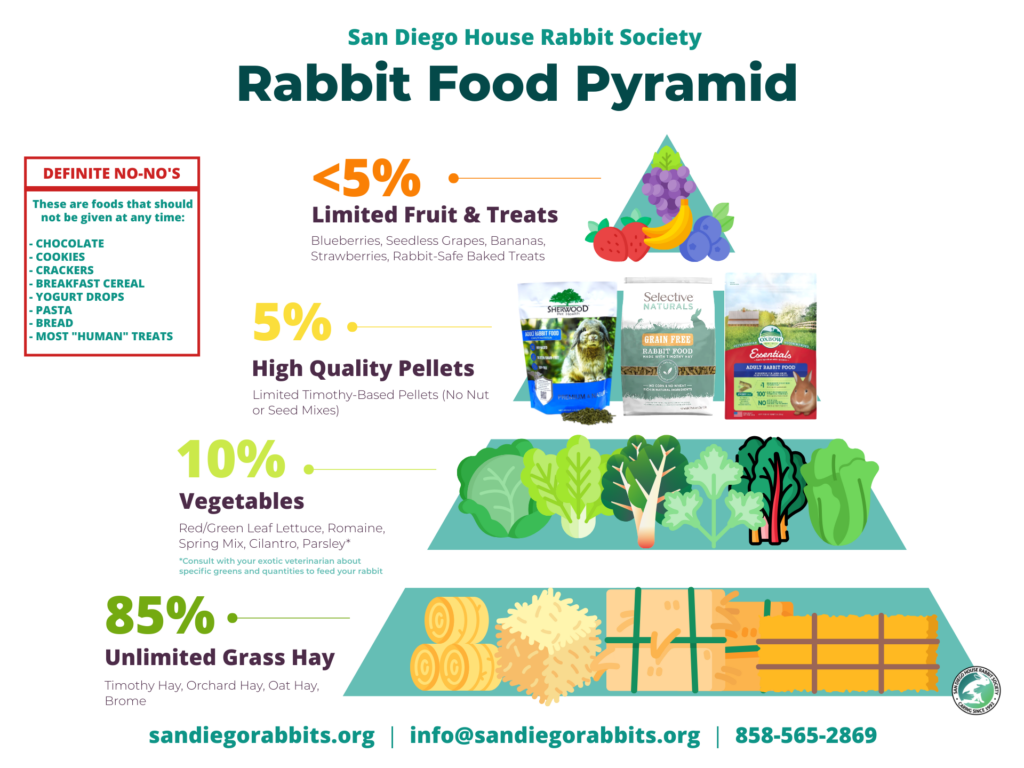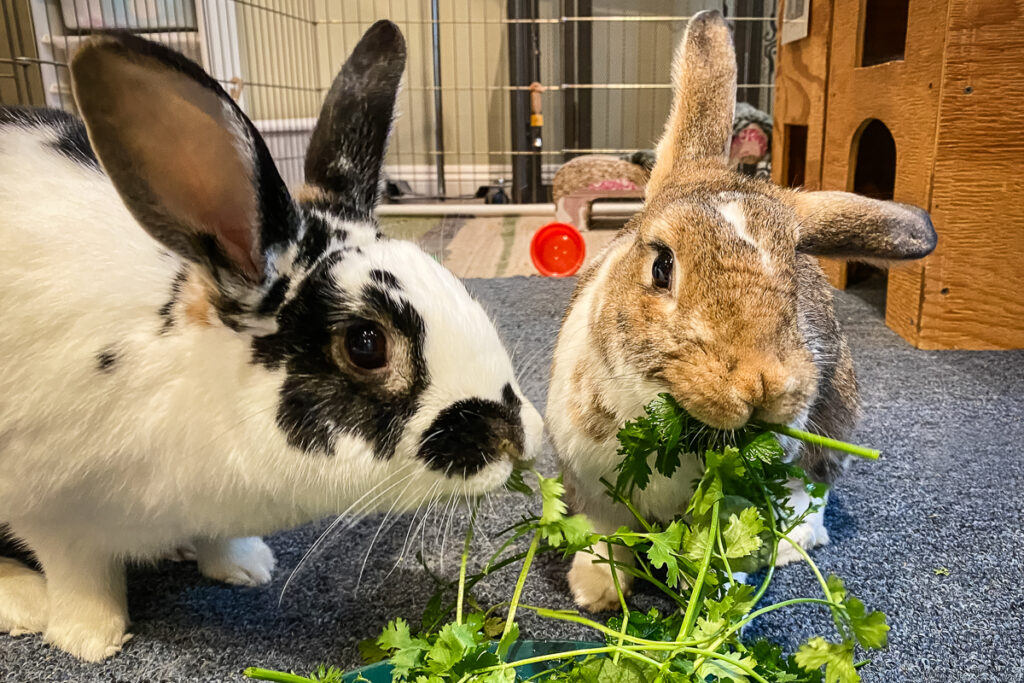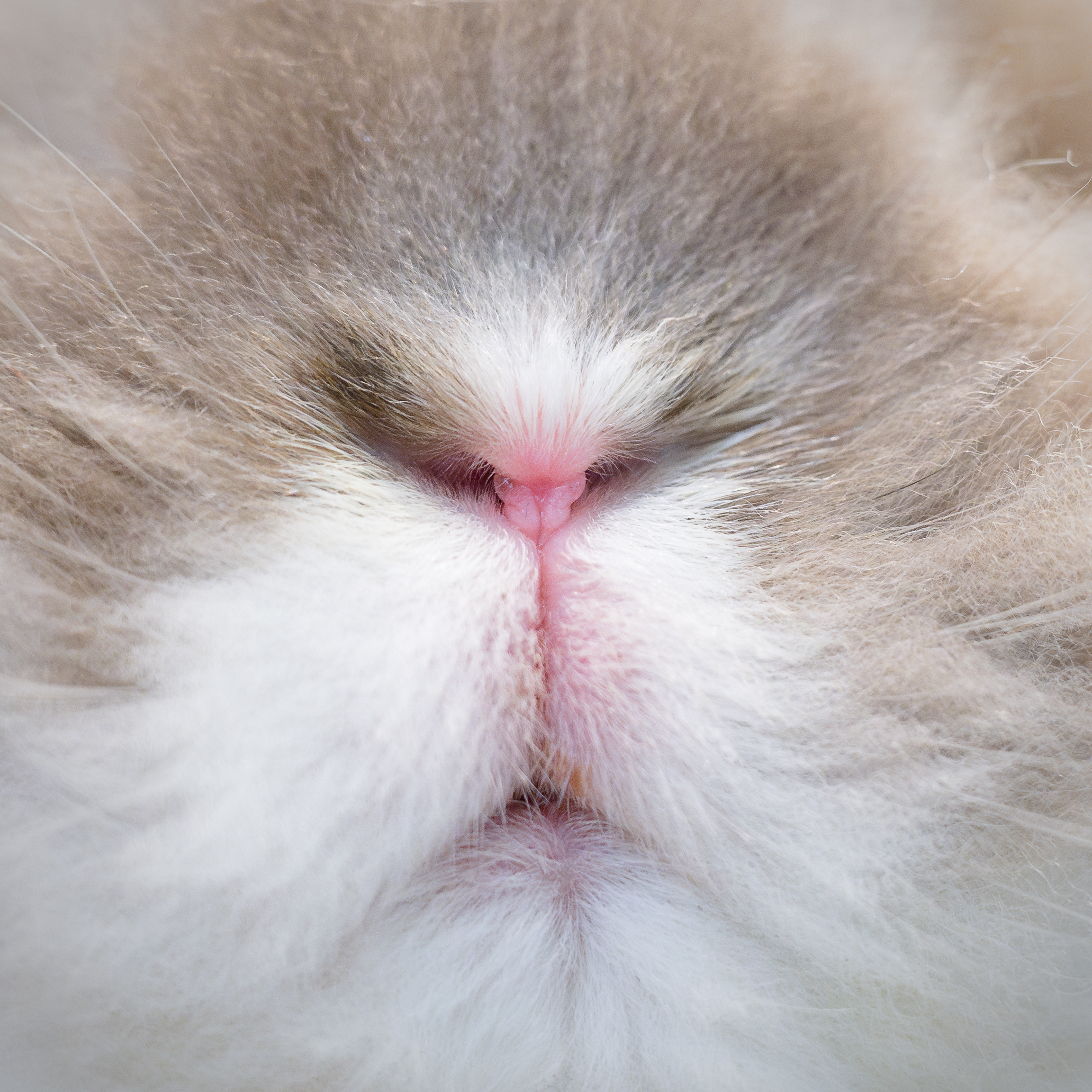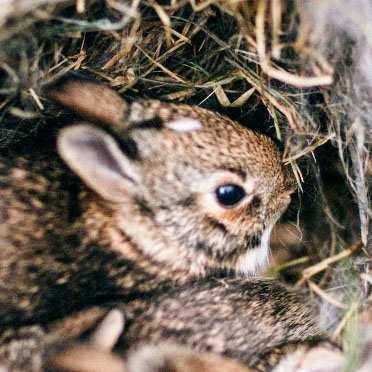Adult rabbits need a balanced diet of unlimited hay, fresh greens, and a few pellets. Anything beyond that is a “treat” and should be given in limited quantities. Want to learn more? Head down the rabbit hole with us to learn about the proper rabbit diet.

Food Sources
85% Hay
Hay is essential to a rabbit’s good health, providing roughage, which reduces the danger of hairballs and other blockages and helps grind down their constantly growing teeth to prevent overgrowth. Hay should comprise 85% of an adult rabbit’s diet.123
Large, unlimited amounts of fresh hay should be offered daily. The following guidelines are suggestions. Consult with your rabbit-savvy vet about diet needs particular to your individual rabbit.
- Introduce hay to baby bunnies as soon as they can eat on their own
- Offer alfalfa hay only to babies, nursing mothers, and elderly or injured rabbits. It’s too low in fiber and too calorie-dense and high in calcium for healthy adult rabbits
- Adult bunnies do best on a mix of timothy hay and other grass hays because they are lower in calories and calcium than alfalfa.
10% Vegetables
Rabbits love fresh vegetables, especially leafy greens. A good rule of thumb is 1-2 cups of vegetables for every four (4) lbs. of body weight. Select at least three types of green leafy vegetables daily to provide a variety of nutrients. When trying out new greens, add only one new type to the diet at a time. Introduce gradually and eliminate if it causes soft stools or diarrhea.4
What kind of veggies should you feed your rabbit? Here’s our suggested veggie list.
5% Pellets
Hay is the foundation of a healthy rabbit diet, not processed pellets, no matter how high quality the pellets may be.
“The uncontrolled feeding of a pelleted diet to a house rabbit can lead to obesity, heart and liver disease, chronic diarrhea, and kidney disease as a result of the high concentration of calories, low fiber, and high calcium levels in the pellets,” — Dr. Susan Brown
Use a good quality, high-fiber timothy-based pellet as a small part of your rabbit’s diet. What makes a good quality pellet? Pellets should be fresh and relatively high in fiber (18% minimum fiber).
Avoid “gourmet” pellets that contain nuts, seeds, or grains. Those multi-colored mixes found in pet stores might look appealing to our human sensibilities, but they are high in carbohydrates and can cause a multitude of health problems for your bunny.
When transitioning to a new type or brand of pellets, don’t jump the gun. Gradually transition by mixing a small amount of the new pellets with the current pellets. Slowly increase the proportion of new pellets over multiple days until you have fully transitioned.
<5% Fruits & Treats
Bunnies have a sweet tooth and, if left to their own devices, will devour sugary foods to the exclusion of healthful ones.
All fruits are considered “treats” because of their high sugar content. Carrots fall into this category as well. Limit these healthy treats to a very small amount once or twice per week. What kind of fruits should you feed your rabbit? Here’s our suggested fruits list.
High glycemic fruits such as bananas and grapes should be used only as occasional treats.
special needs
Some rabbits have special dietary needs. Your vet might recommend different proportions of hay/veggies/pellets in your rabbit’s diet in special circumstances. For example:
- Long-haired rabbits such as Lion Heads, Angoras, Jersey Woolies may have higher protein/pellet needs to support the growth of their long fur.
- Overweight rabbits might need fewer pellets until they reach their ideal weight.
- Older, ill, or underweight rabbits may need more pellets or calorie-dense foods to help them gain weight or build up strength as they recover.
- Mother rabbits nursing their babies need access to unlimited pellets and hay. It takes a lot of calories to produce milk for babies.
- Rabbits with chronic digestive issues (such as megacolon) may need a completely different diet.
For all of these special cases above, consult with a rabbit-savvy vet to be sure your rabbit is on a diet appropriate for their own special needs.
What About HUMAN FOOD?
Processed human foods are especially dangerous for rabbits and their delicate digestive systems5. This includes chocolate, cookies, crackers, breakfast cereals, bread, pasta, yogurt drops or other “human treats.” 6
Video Summary of Rabbit Dietary Needs
Further Reading
Providing a Health Rabbit Diet, San Diego House Rabbit Society.
Diet, WabbitWiki.com
Rabbit Feeding, MediRabbit.com
References
- Rabbit Diet: What to Feed a Pet Bunny, Best Friends Sanctuary. ↩︎
- Vegetables, WabbitWiki. ↩︎
- Providing a Health Rabbit Diet, San Diego House Rabbit Society. ↩︎
- Providing a Health Rabbit Diet, San Diego House Rabbit Society. ↩︎
- Moore, L. (2017). Rabbit nutrition and nutritional healing. (3rd ed.) ↩︎
- Yogurts and Dairy for rabbits, Medirabbit. ↩︎



